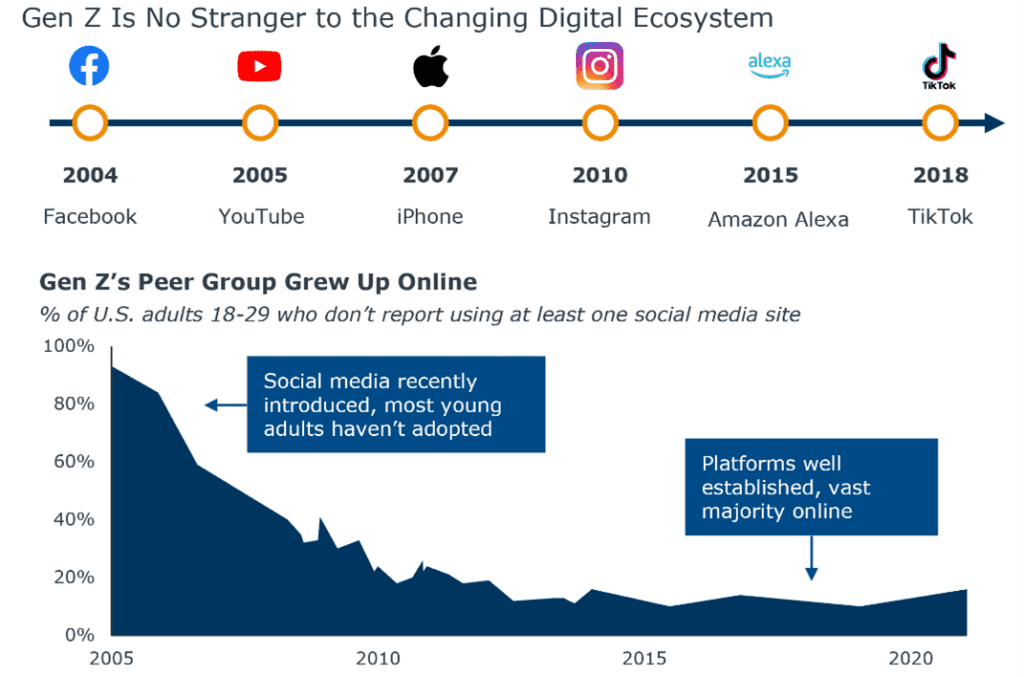What advancement leaders can learn from enrollment leaders about Gen Z
There’s no denying the profound impact Generation Z has had on higher education. The first generation exposed to technology from an early age, Gen Z is comprised of “digital natives.” Students in this generation are changing the way institutions create and execute engagement strategies—from enrollment to retention to alumni giving—requiring them to be more customized and digitally omnipresent than ever before.
More on Gen Z
Born between the late 1990s and early 2010s, this generation makes up current middle school students through recent college grads. They are described as digitally-savvy, entrepreneurial, self-directed, and discerning. But also have higher tendencies to be stressed, anxious, and overwhelmed with limited attention spans. Explore more insights about Gen Z.
Institutions have worked diligently to learn the values and behaviors of this new generation. As the “demographic cliff” nears, enrollment teams across the country are focused on meeting the needs of these students and finding the best ways to engage them now and in the future.
The impact of what we have learned so far can extend beyond enrollment strategies and Gen Z. That’s why I tapped enrollment leaders at EAB to see what insights they can share that could help advancement leaders reach a whole new generation of donors while better engaging their existing ones. Here’s what they had to say.
1. Personalize and tailor to the individual
The first lesson we have learned from Gen Z is the high impact and reward of personalized campaigns. This means more than just dropping in a first name in the salutation. It’s about creating a suite of impactful communications and content that showcases where your audience has expressed interest. We know that donors who actively engage with your content throughout the year are more likely to donate when you make a direct ask. So how can you keep them engaged? By sending them content that is relevant to them.
-
80%
of donors prefer to receive one form of personalized content.
One example from my enrollment colleagues is sending an introductory communication containing a call-to-action for students to select an area of the institution they are most interested in (i.e., campus life, athletics, grad programs). Future messages are then tailored based on their response. Not only does this make it more likely that they will continue engaging with the content, but can lead them to take action.
This same tactic can be applied to your advancement strategy. Start by sending an introductory email to your donor database with areas of your institution they could give to or simply learn more about. Then, tailor all future communications around their selection of interest. Sending your donors information they care about will keep them engaged and more likely to consider your institution when planning out their charitable giving.
2. Integrate yourself into their digital world
In addition to personalization, enrollment leaders have learned the importance of being present in their audience’s digital worlds. The emergence of Gen Z’s social media habits has had a strong influence on how people of all ages use digital platforms—integrating them more into our daily lives than ever.
Understanding what platforms your donors and alumni are on, and how they use them, is crucial in creating authentic connections that will more likely lead them to donate to your institution. In recent years our partners have shown an increase of 26% in digital gifts, making it clear your audience is online, and you should be too.

When building out your digital strategy, it’s important to include content that will engage your audience without only asking them to give. Personalized content that showcases impact, thought leadership, and relevant topics will help you join the conversations your audience is already having online, making it easier to get in front of them. Your focus should be having enough content on the right channels so that when they are ready to give, your institution is top of mind.
Expanding your digital strategy can also help you reach more alumni and prospective donors that you are not currently engaging with. Here are two digital marketing tactics to reach new audiences:
- Create targeted digital campaigns based on the demographics and psychographics that align with your institution’s values and goals. This can include age, location, occupation, giving history, hobbies and interests, income levels, and more.
- When setting up a new digital campaign, utilize your existing lists to create lookalike audiences for your campaign that will find alumni on their preferred social channels even if they have not updated their contact records with your institution.
FIVE RECOMMENDATIONS TO IMPROVE YOUR ALUMNI/DONOR DIGITAL EXPERIENCE
3. Involve families
Finally, when considering how to engage your donor pool, don’t overlook your alumni’s families. EAB enrollment leaders have learned that not only do parents and guardians want to be involved in their Gen Z’s college search, but they are also highly influential in the decision-making process. EAB’s recent parent survey research showed that the overwhelming majority of parents want to be communicated with directly during the enrollment process.
-
75%
of parents in 2022 indicated colleges should communicate with them directly.
Once you start to include parents in your campaigns, it’s key to cater the messaging to what’s important to them. Just as parents and guardians have different interests at different times than their students during the enrollment process, so do the parents and guardians of your current students and alumni. When building out communications to families, be sure to include information and giving opportunities that are interesting and relevant to them.
As discussed in our recent webinar, a parent or guardian who was engaged during a student’s time as an undergrad can be a qualified lead for a new donor. The parent may even be more apt and quicker to donate than their alumnus.
![]()
What we’ve learned about Gen Z’s behaviors and preferences during the enrollment process can be applied to your advancement strategies for Gen Z as well as future generations. As alumni behaviors continue to shift, we will continue to discover effective ways to reach and engage your audiences.

More Blogs

The old advancement staffing model no longer works

How to grow your donor pipeline in today's climate
